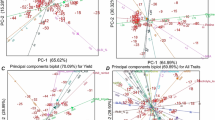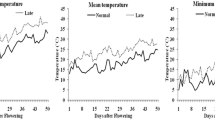Abstract
Chickpea is one of the most important grain legume crops in the world. India is the largest producer, consumer as well as importer of chickpea. Cold stress (temperature < 15 °C) is one of the important abiotic stresses limiting chickpea production by hampering its growth and vigor at all phenological stages. This study was aimed to characterize a diverse set of 366 chickpea genotypes for cold tolerance and identify most promising cold tolerant chickpea genotypes in the Western-Himalayas of Jammu and Kashmir, India. The 366 genotypes used during the present study including genotypes belonging to cultivated, primary and secondary gene pools of chickpea. Two important approaches were used including visual screening under field conditions and screening under controlled conditions by measuring cell membrane stability through electrolyte leakage tests. The analysis of trait data collected through both the approaches led to the identification of five most promising/candidate cold tolerant chickpea genotypes including one wild genotype “Ortan-066” from secondary gene pool species (C. echinospermum), one wild genotype “Cudi 1-022” from primary gene pool species (C. reticulatum) and three genotypes (IC 116783, ICC 15200 and AGBLG 170004) from the cultivated species (Cicer arietinum). Wild genotype “Ortan-066” was found best cold tolerance source with the mean Cold Tolerance Rating (CTR) of 2 and Electrolyte Leakage Index (ELI) of 10.82%, followed by wild genotype “Cudi 1-022” (CTR = 3, ELI = 18.89%), and three cultivated genotypes viz., IC 116783, ICC 15200 and AGBL-G-170004, with the mean CTR of 3 and an estimated mean ELI of 21.26%, 21.58% and 21.94%, respectively. The promising, candidate cold tolerant genotypes identified during the present study could be used in chickpea breeding programs aimed at improving cold tolerance of cultivated chickpea worldwide. The candidate lines can be also used for developing bi-parental mapping populations, wild × cultivated introgression lines, transcriptomics and for differential expression analysis of cold tolerant genes in chickpea.




Similar content being viewed by others
References
Abbo S, Lev-Yadun S, Galwey N (2002) Vernalization response of wild chickpea. New Phytol 154:695–701
Arslan O, Eyidogan F, Ekmekci YASEMİN (2018) Freezing tolerance of chickpea: biochemical and molecular changes at vegetative stage. Biol Plant 62(1):140–148
Berger JD, Ali M, Basu PS, Chaudhary BD, Chaturvedi SK, Deshmukh PS (2006) Genotype by environment studies demonstrates the critical role of phenology in adaptation of chickpea (Cicer arietinum L.) to high and low yielding environments of India. Field Crop Res 98:230–244
Berger JD, Kumar S, Nayyar H, Street KA, Sandhu JS, Henzell JM, Clarke HC (2012) Temperature-stratified screening of chickpea (Cicer arietinum L.) genetic resource collections reveals very limited reproductive chilling tolerance compared to its annual wild relatives. Field Crop Res 126:119–129
Chaturvedi SK, Jha SK, Singh NP, Gaur PM, Varshney RK (2018) Technological and policy intervention for increasing chickpea production in India. Pulse India 8:7–12
Chohan A, Raina SK (2011) Comparative studies on morphological and biochemical characters of chickpea genotypes under chilling stress. J Environ Biol 32(2):189–194
Clarke H, Siddique K (2004) Response of chickpea genotypes to low temperature stress during reproductive development. Field Crop Res 90:323–334
Croser JS, Clarke HJ, Siddique KHM, Khan TN (2003) Low temperature stress: Implications for chickpea (Cicer arietinum L.) improvement. Crit Rev Plant Sci 22:185–219
Demidchik V, Straltsova D, Medvedev SS, Pozhvanov GA, Sokolik A, Yurin V (2014) Stress-induced electrolyte leakage: the role of K+-permeable channels and involvement in programmed cell death and metabolic adjustment. J Exp Bot 65(5):1259–1270
Duke JA (1981) Handbook of legumes of world economic importance. Plenum Press, New York, pp 52–57
Fathi E, Tahmasebi I, Teimoori N (2016) Electrolyte leakage and catalase peroxidase activity in chickpea genotypes seedling, in response to low temperature. Agroecol J 12(2):25–33
Gaur PM, Jukanti AK, Varshney RK (2012) Impact of genomic technologies on chickpea breeding strategies. Agronomy 2:199–221
Gaur PM, Samineni S, Thudi M, Tripathi S, Sajja SB, Jayalakshmi V, Dixit GP (2019) Integrated breeding approaches for improving drought and heat adaptation in chickpea (Cicer arietinum L.). Plant Breed 138(4):389–400
Heidarvand L, Amiri RM, Naghavi MR, Farayedi Y, Sadeghzadeh B, Alizadeh K (2011) Physiological and morphological characteristics of chickpea accessions under low temperature stress. Russ J Plant Physiol 58(1):126–132
Janska A, Marsik P, Zelenkova S, Ovesna J (2010) Cold stress and acclimation—What is important for metabolic adjustment? Plant Biol 12(3):395–405
Jha UC, Chaturvedi SK, Bohra A, Basu PS, Khan MS, Bahr D (2014) Abiotic stresses, constraints and improvement strategies in chickpea. Plant Breed 133:163–178
Kalaji HM, Jajoo A, Oukarroum A, Brestic M, Zivcak M, Samborska IA, Center MD, Łukasik I, Goltsev V, Ladle R (2016) Chlorophyll a fluorescence as a tool to monitor physiological status of plants under abiotic stress conditions. Acta Physiol Plant 38(4):102
Kanouni H, Malhotra KM, RS, (2009) Assessment of cold tolerance of chickpea at rainfed highlands of Iran. Am-Eurasian J Agric Environ Sci 5:250–254
Kumar S, Malik J, Thakur P, Kaistha S, Sharma KD, Upadhyaya HD, Nayyar H (2011) Growth and metabolic responses of contrasting chickpea (Cicer arietinum L.) genotypes to chilling stress at reproductive phase. Acta Physiol Plantarum 33(3):779–787
Lutts S, Kinet JM, Bouharmont J (1996) NaCl-induced senescence in leaves of rice (Oryza sativa L.) cultivars differing in salinity resistance. Ann Bot 78(3):389–398
Malhotra RS, Saxena MC (1993) Screening for cold and heat tolerance in cool-season food legumes. Wiley, New York, pp 227–244
Mallikarjuna BP, Samineni S, Thudi M, Sajja SB, Khan AW, Patil A, Viswanatha KP, Varshney RK, Gaur PM (2017) Molecular mapping of flowering time major genes and QTLs in Chickpea (Cicer arietinum L.). Front Plant Sci 8:1140
Mir AH, Bhat MA, Fayaz H, Dar SA, Maqbool S, Bhat NA, Thudi M, Mir RR (2019) Assessment of cold tolerance in chickpea accessions in North-Western Himalayas of Jammu and Kashmir India. J Pharm Phytochem 8(4):2268–2274
Muehlbauer FJ, Sarker A (2017) Economic importance of chickpea: production, value, and world trade. In: Varshney RK, Thudi M, Muehlbauer F (eds) The chickpea genome. Springer, Cham, pp 5–12
Nayyar H, Bains T, Kumar S (2005) Low temperature induced floral abortion in chickpea: relationship to abscisic acid and cryoprotectants in reproductive organs. Environ Exp Bot 53(1):39–47
Rani A, Devi P, Jha UC, Sharma KD, Siddique KH, Nayyar H (2020) Developing climate-resilient chickpea involving physiological and molecular approaches with a focus on temperature and drought stresses. Front Plant Sci 10:1759
Robertson LD, Singh KB, Ocampo B (1995) A catalog of annual wild Cicer species. Publisher ICARDA, Syria
Roorkiwal M, Jain A, Kale SM, Doddamani D, Chitikineni A, Thudi M, Varshney RK (2018) Development and evaluation of high-density Axiom® Cicer SNP Array for high resolution genetic mapping and breeding applications in chickpea. Plant Biotechnol J 16(4):890–901
Ruelland E, Vaultier MN, Zachowski A, Hurry V (2009) Cold signalling and cold acclimation in plants. Adv Bot Res 49:35–150
Singh KB, Malhotra RS, Saxena MC (1989) Chickpea evaluation for cold tolerance under field conditions. Crop Sci 29:282–285
Singh KB, Malhotra RS, Saxena MC (1990) Sources for tolerance to cold in Cicer species. Crop Sci 30(5):1136–1138
Singh KB, Malhotra RS, Saxena MC (1993) Relationship between cold severity and yield loss in chickpea (Cicer arietinum L.). J Agron Crop Sci 170:121–127
Singh KB, Malhotra RS, Saxena MC (1995) Additional sources of tolerance to cold in cultivated and wild Cicer species. Crop Sci 35(5):1491–1497
Singh KB, Ocampo B, Robertson LD (1998) Diversity for abiotic and biotic stress resistance in the wild annual Cicer species. Genet Resour Crop Evol 45(1):9–17
Srinivasan A, Saxena NP, Johansen C (1999) Cold tolerance during early reproductive growth of chickpea (Cicer arietinum L.): genetic variation in gamete development and function. Field Crop Res 60:209–222
Toker C (2005) Preliminary screening and selection for cold tolerance in annual wild Cicer species. Genet Resour Crop Evol 52(1):1–5
Wery J (1990) In: Saxena MC, Cubero JI, Wery J (eds) Present status and future prospects of chickpea crop production and improvement in the Mediterranean countries, Options Mdditerran6ennes- Sdrie SBminaires -n° 9 - CIHEAM, Paris, pp 77–85
Wery J, Lecoeur TO (1993) Mechanisms of resistance to cold, heat and drought in cool-season legumes, with special reference to chickpea and pea. Wiley, Chichester, pp 270–291
Author information
Authors and Affiliations
Corresponding author
Additional information
Publisher's Note
Springer Nature remains neutral with regard to jurisdictional claims in published maps and institutional affiliations.
Supplementary Information
Below is the link to the electronic supplementary material.
Rights and permissions
About this article
Cite this article
Mir, A.H., Bhat, M.A., Dar, S.A. et al. Assessment of cold tolerance in chickpea (Cicer spp.) grown under cold/freezing weather conditions of North-Western Himalayas of Jammu and Kashmir, India. Physiol Mol Biol Plants 27, 1105–1118 (2021). https://doi.org/10.1007/s12298-021-00997-1
Received:
Revised:
Accepted:
Published:
Issue Date:
DOI: https://doi.org/10.1007/s12298-021-00997-1




